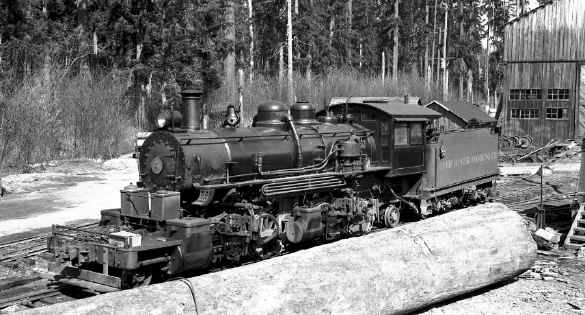Deep River #7(SKOOKUM) |
|
One of the most famous of all logging locomotives is the
Skookum. This engine was
the very first logging mallet built by the Baldwin Locomotive Works in
1909 and only one of three 2-4-4-2 wheel arrangement engines ever built.
This engine was originally built for the Little River RR in Townsend
Tennessee as their #126. They
wanted to experiment with a small mallet for their light track.
Unfortunately the engine proved to be too heavy and many
derailments during testing showed that the engine would simply not work
for Little River. The buyer
rejected the engine and returned her in new condition to Baldwin Baldwin quickly found a buyer on the West Coast for the
Skookum. The Columbia Belt Line of
Blind Slough, Columbia was looking for a powerful rod-engine that would
work on their logging railroad. Baldwin repainted the engine and gave
her a name rather than a number. She
was named "Skookum", a Chinook Indian word meaning strong,
good & powerful". This
was exactly the image Baldwin wanted to portray for this, the very first
logging Mallet locomotive built. The little 2-4-4-2 worked beautifully.
She exceeded all expectations and led the way for Baldwin to build
nearly 50 more logging Mallets for use on other logging railroads. The Skookum was typical of many logging locomotives of
that era. When one logger
would cut-out their timber the engine would be re-sold to another logger
for use on their railroad. The
Skookum worked for 3 different operators until being sold to a logger in
Washington. She ended her
career on the Deep River Logging Co. at Deep River, WA.
By this time her name "Skookum" had been replaced with
#7. The
fact that #7 was saved was a measure of both bad luck and good luck.
In February 1955 Deep River was nearing the end of their timber
and thus the use of their logging railroad.
They planned to scrap the railroad and locomotives by the end of
that year.
By this time Deep River had only 2 locomotives left, a big ALCO
2-6-2 and the #7. The preferred engine was the #7 because of its greater
power and traction.
On February 23, 1955 while the #7 was backing her train of cars
across a short trestle she hit a piece of broken rail and her tender
derailed causing the whole locomotive to lean precariously to one side.
The crews got out and assessed the situation.
The engine seemed stable enough to the crew and since nighttime
was approaching they planned to leave the engine until the next morning
when they could return with the
2-6-2 and help re-rail the #7.
With
the engine leaning heavily to one side the fireman decided to add water
to the boiler so the crown sheet would stay covered with water
overnight.
As the water was injected into the boiler the center of gravity
for the engine raised.
As the crew watched with amazement
the engine breathed a sigh and fell over on her side off the
short trestle.
Even though the soft ground where the engine fell prevented
damage to the engine the crew now had an engine completely off
the track laying in a stream bed. Re-railing #7 was now a major job. Since
the railroad had only a few months of work left and since the big 2-6-2
was available for service, Deep River decided to leave #7 in the woods
and simply complete the logging with the ALCO.
When it came time to scrap the line in late 1955, the #7 was too
remote for the scrapper to conveniently scrap the engine and get the
pieces out.
The rail was pulled up and #7 was simply abandoned laying on her
side in the woods.
The
rail fan community had long known of this famous first logging mallet
built by Baldwin.
When rail fan Charlie Morrow learned that #7 was abandoned in the
woods he bought her from the scrapper "as-is, where-is".
Getting the engine out was no small trick since the railroad had been
pulled up and no roads were near-by.
Mr. Morrow and his friends had to disassemble the 1909 locomotive
in the woods and take her out piece-by-piece.
The boiler had been on the frame since 1909 and was difficult to
separate.
Mr. Morrow had to resort to using dynamite to blast the boiler
off the frame. Morrow
was one of the founding members of the Puget Sound RR historical Society
and #7's pieces were moved to the museums facility in Snoqualmie, WA
where it sat in pieces until sold to Rogan Coombs in 1996.
Mr. Coombs, a California logger moved the Skookum to the Mount
Rainer Scenic RR shops in Mineral in 1996 so the engine can be repaired,
reassembled and operated for future generations to enjoy. Specifications: This
71-ton logging mallet was built by the Baldwin Locomotive Works in
Philadelphia, PA. for the Little River Railroad in Townsend, TN:
Ownership
History:
Photographs and information courtesy of Martin E. Hansen |
| HOME | ||||
| Cams/Plating |
